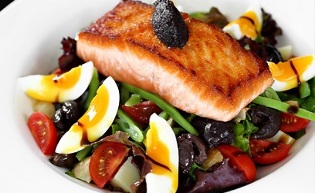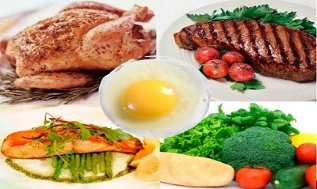How many times have you had to reread a number of very effective diets that help you lose subcutaneous fat? Do you know why there are over 10, 000 possibilities for various activities to lose weight in the world? It's simple: because 90% of them are ineffective. Protein diet for weight loss is a good option, but it can also be ineffective if used incorrectly. How to use protein for weight loss without harm to health with maximum results?
How to lose weight on a protein diet?
To get rid of subcutaneous fat, you need to know your body's physiological needs, understand when to eat carbs and when to eat protein, and to be able to listen to your body, which gives you an unlimited number of instructions, if we follow a wrong diet.
Of course, most people already know that if you limit your intake of sweet and complex carbohydrates, it is possible to achieve significant weight loss, a specific number depends on the percentage of fat in the human body. This can be called a low carb diet which is a very effective way to get rid of fat. The calorie deficit created by minimizing carbohydrate intake is completely filled with fat. As a result, people are losing weight by restricting the use of carbohydrates in their diet.
What happens if we completely deplete carbohydrates from our diet?
Do we get a better way to lose weight? Our answer: of course, yes. This diet was especially popular during the golden age of fitness and was widely promoted by Vince Gironde. You just have to look at his picture and it immediately becomes clear why he recommended it. The name of the best, according to many nutritionists, are methods for successful fat burning protein diets.

Weight loss protein is a carbohydrate-free diet consisting solely of protein foods and healthy body fats. Carbohydrate calories are fully supplemented with animal protein. This method not only allows you to get rid of fat as well as possible, but also to speed up your metabolism and preserve muscle tissue as much as possible.
Many diets take almost no account of the last two factors: their main goal is simply to reduce your total daily calorie intake, which does not have a very positive effect on your weight loss condition.The body sees a significant reduction in calorie intake as a threat to life, begins to slow down metabolism and transports all food consumed into subcutaneous fat and uses muscle fibers for energy consumption. It turns out that at the end of this method of losing weight, one creates ideal conditions for gaining weight and does everything to burn muscle mass. We hope you have now lost the desire to try the famous diet diet?
The Principles of Protein Diet
When we create an environment where carbohydrates are completely removed, ketone bodies begin to get rid of subcutaneous fat, which are the main source of energy for the brain and nervous system.
To make it clearer, it is necessary to explain that all the foods we eat contain more or less three nutrients, each of which plays its own role in supporting the body's life. These are fats, proteins and carbohydrates:- Proteinis a building block for our body, where energy is rarely used.
- Fatis stored energy stored in emergencies and fat is also used to protect internal organs.
- Carbohydratesare fully responsible for the body's energy supply.
Now it's clearer why we want to eat sugary or complex carbohydrates when we're hungry? Because it is carbohydrates that are the main source of energy for our body and proteins and fats remain in reserve. Therefore, in everyday life, you want to eat exactly sweet and complex carbohydrates: this is the most effective way to supply your body with energy. And that's why people do not like to exclude foods that contain carbohydrates from their diet. The body does not understand that one deliberately excludes the main source of energy. Your body thinks you are living in harsh living conditions and you are starving. If carbohydrates do not start flowing in the shortest possible time, the body is forced to unpack emergency fat stores.
What happens if you continue to limit your carb intake?
First, your body will deplete all of its glycogen stores, which will last for a short time, and only after that will it switch to independent nutrition due to protein and fat. The protein diet has a large number of positive reviews from people who have achieved incredible results thanks to this method of losing weight. To be honest with you, everyone in the world of diet has the basics of the protein method to lose weight. Read all the one-diet carefully and between the lines you will see the basics we are discussing in our article. Of course, if the author of the diet, which you will read, presented it correctly.
It is important to add the important point that adding about 50 grams of carbohydrates in a rigid protein diet will not cause the blood sugar in individuals to rise. This means that the body will continue to feed on adipose tissue to ensure a positive energy balance in the body.
Should you eliminate carbohydrate intake in protein diets?
This result has many pluses and one small minus. The positive side is that the complete elimination of carbohydrates leads to the rapid depletion of glycogen stores and it causes the body to start using fat stores as soon as possible. And the reason for everything is our old friend insulin. It is his presence or absence that determines what type of energy the body will expend. Here everything is simple: the less carbohydrates you eat, the less insulin is secreted. Inflammation of this hormone completely prevents the breakdown of fat (the breakdown of adipose tissue) completely. It can be concluded that a protein diet eliminates the insulin wave and has the full effect of lipolysis.
What is the main disadvantage of a protein diet?
In order to maintain normal gastrointestinal function, it is necessary at least occasionally to consume fiber, which is found where? That's right, in carbohydrates. Failure to do so can lead to problems such as constipation, which is quite unpleasant news. Therefore, we strongly recommend that you do not exclude vegetables such as cucumbers, tomatoes and cabbage from your diet in a protein diet. They will keep your digestive tract fully active.
Harmful of protein foods
Protein diet damage can only occur if you start consuming too much protein and completely eliminate fiber from your diet. And all these actions will be applied for a long time, then the failure of the body will begin. We strongly recommend that you consult your doctor and nutritionist before using the above system. Because there is a considerable list of diseases where the use of protein foods alone is unacceptable. Good health to all and finally become the owners of a fascinating image in your city.
How long is the protein diet?

- There is a possibility of a stable diet: for a long time you eat only protein, healthy fats and fiber.
- Dietary strengthis only used on training days. You make a carb load about two hours before your workout to provide glycogen and significantly increase exercise. Every other day a protein diet.
- Circular use of protein foods. This option allows for a carbohydrate load once a week throughout the day. This will help to preserve muscle mass as much as possible and increase metabolism even further. This is the method we recommend to use for anyone who wants to make the body worthy of its spirit. Although you can experiment and choose the option that suits you best.
What to eat with a protein diet: food
Probably the answer will not surprise you if we say that these are foods that contain animal protein. It is best to use lean meats such as veal, beef, chicken breast and rabbit. Choose foods from dairy products that do not contain high levels of fat, but you should not eat only low-fat kefir. Fat content up to 10% is quite suitable. This is normal, there is no need to worry. "Remember that fat burns on carbohydrates. "Be sure to eat fish: it is not only high in protein, but also a source of healthy omega fat. Do not forget about eggs as a guideline for adaptation among all the above products.
It should be 5 to 10 meals a day, in fact the better. Therefore, all food must be prepared in the morning and distributed evenly in the bowls: this makes it possible to open a container with food at any time of the day and consume the necessary food.
Example of a weekly menu
This is what the 7-day protein food menu might look like or could be extended by 14 days.
Monday
- packaging of fat-free cottage cheese;
- jar of yogurt, 1 grapefruit;
- 2 chicken breasts, broccoli, half a glass of kefir;
- jar of yogurt, grated medium yellow carrots;
- 1 liter of still water, a glass of natural apple juice.
Tuesday
- yogurt, green apple;
- 100 g of meat, cheese, tomatoes, 1 pepper;
- 200 g of fish, celery salad, carrots and apples;
- 2 hard-boiled eggs, cabbage salad with parsley and lemon juice;
- 1 liter of water, 1 glass of currant juice.
Wednesday
- yogurt, strawberry glass;
- granular cottage cheese with a spoonful of chopped parsley, red pepper and tomato paste;
- 2 chicken breasts, a cup of spinach, half a cup of kefir;
- any stew, zucchini, 1 tomato, 2 tablespoons of dill (you can mix vegetables and add 2 tablespoons of olive oil), 2 slices of ham;
- 1 liter of water, a glass of orange juice.
Thursday
- packaging of fat-free cottage cheese;
- glass of kefir, ½ cup of raspberries;
- 200 g stew, 1/3 cup milk, carrots;
- 2 eggs, cabbage salad with peppers and parsley, seasoned with lemon juice;
- 1 l. water, a glass of currant juice.
Friday
- yogurt, 2 mandarins;
- granular cheese (1 pack);
- 200 g sea fish, tomato, red pepper and parsley salad, yoghurt;
- granular cottage cheese (1 pack), carrots, green apples;
- 1 liter of water, a glass of orange juice.
Saturday
- 100 g of cottage cheese, skimmed milk;
- glass of kefir;
- 2 chicken breasts, beans, yogurt;
- 2 slices of ham, broccoli, 1 egg, 2 tablespoons of cereal;
- 1 l. water, a glass of currant juice.
Sunday
- a glass of kefir, a glass of raspberry (or other berry);
- grainy cheese, ham slice;
- stewed chicken liver, salad with lemon juice, apples;
- yogurt with added fruit;
- 1 liter of water, a glass of apple juice.














































































